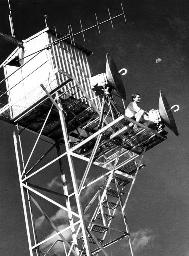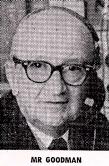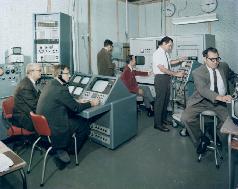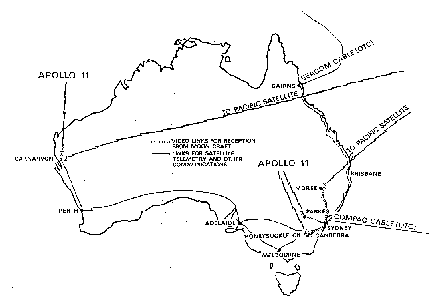
Photo CSIRO: the PMG microwave dishes on the East-West service tower. This is an Apollo 12 picture, but the dishes were similar for Apollo 11.
 Photo CSIRO: the PMG microwave dishes on the East-West service tower. This is an Apollo 12 picture, but the dishes were similar for Apollo 11. |
Once received at Parkes, the composite signal was sent by microwave link to the PMG Waverley exchange in Sydney, then onto the OTC Paddington terminal just a few kilometres from Waverley. The PMG microwave link at Parkes was located on the east-west service tower, about 100 metres due east of the telescope. Two AWA microwave dishes transmitted the signal to Mt Coonambro about 30 km southeast of the telescope. Each of the dishes operated at different frequencies-the main link was at a frequency of 4 GHz, and the backup was at 7 GHz. They operated on a hot-standby mode, which meant that in the event of a failure in the main link, the signal would immediately switch to the backup without any loss of data. From Mt Coonambro the signal was sent on a 4 GHz link to the West Orange repeater, and from there it was fed down the 6 GHz PMG bearers to Redfern, and on to the Waverley exchange.
At Paddington, the TV and telemetry were separated and distributed. Since the TV was modulating the baseband, the telemetry subcarriers were first removed from the TV signal by using notch filters to null them. The television pictures were then scan-converted and forwarded on to Houston. The filtered voice, telemetry and biomedical subcarriers were sent on to Honeysuckle Creek via PMG microwave link and the Deakin telephone exchange in Canberra.
In Sydney:
 |
 Photo courtesy of Richard Holl: The scene in the OTC Paddington terminal. (L-R) Charlie Goodman, Verne McGlynn, Richard Holl, Elmer Fredd, Ted Knotts, and Ray Louve. |
Richard Holl, seen standing with his back to camera, was the Bendix Field Engineering Corporation engineer who helped design modifications to the RCA scan-converters. He was the first to arrive in Sydney, and with the help of OTC technician, Wayne Ozarko, he installed all the equipment seen in the photograph. Elmer Fredd is seated at the scan-converter. To his right is Ted Knotts standing at an oscilloscope. Ray Louve is sitting in front of an Ampex VR660 video recorder.
Behind Charlie, just out of view, was another room known as the International Telecommunications Operating Centre (ITOC). Here the OTC personnel controlled the relays that fed the signals to Charlie Goodman and his team. In charge of ITOC was Bob Goodman (who was no relation to Charlie). Bob was the OTC International Co-ordinator for all the transmissions between Australia and the USA. There was a glass-panelled wall separating the two rooms that allowed the OTC and ABC personnel to monitor the broadcast from the Moon.
At Honeysuckle Creek:
At Honeysuckle Creek, the signal from Parkes was fed into the S-band Data Demodulation System (SDDS) and the telemetry was extracted. The Parkes main signal was fed into the demodulator DEMOD 4 and the backup (off-axis signal) was fed into DEMOD 2. The Parkes telemetry was synchronised and blocked with the Honeysuckle Creek telemetry, and sent on to Houston via the Deakin Telephone Exchange. The entire ground floor of the exchange was given over to NASA and it was known as the NASA Communication Centre in Canberra (NASCOM). From there the telemetry was sent back to the OTC terminal at Paddington, Sydney, and then on to the OTC Moree Earth Station, in northern NSW. Finally, from there the signal was transmitted via the INTELSAT III (3F4) Pacific geostationary communications satellite to Jamesberg, California. From there the signal went to Houston via San Francisco along the lines of the AT&T company.
Voice and command:
Voice and command communications between Parkes, Honeysuckle Creek, and Sydney Video were provided by existing PMG telephone circuits. Two local telephone exchanges were used at Parkes. The main circuit was from the Observatory to the country automatic exchange at Beargamil about five km to the east of the telescope. The alternative, stand-by circuit was the Alectown manual exchange about 10 km north of the telescope. A senior PMG technician, Brian Coote, was present in the control room of the telescope and his task was to monitor the communications network. This network was referred to as NET 7.
Post Master General's Department (PMG) involvement:
The whole range of facilities of the Post Office was used - coaxial cable, microwave radio, and open wires. Alternative circuits, sometimes even a third circuit, were available in case of a failure. Experts had checked and double-checked all the security aspects of the relays.
Sixteen thousand kilometres of trunk circuits were used for over a week. Just the television relay network over the eastern states covered 8,046 km, all looked after by more than 100 engineers and technicians working around the clock. These links were being carried free of charge by the PMG as the Apollo 11 relays were regarded as programs of national importance. (Lindsay 1998).
 Photo courtesy of Hamish Lindsay: The communications links provided by Australia for the Apollo 11 mission. |